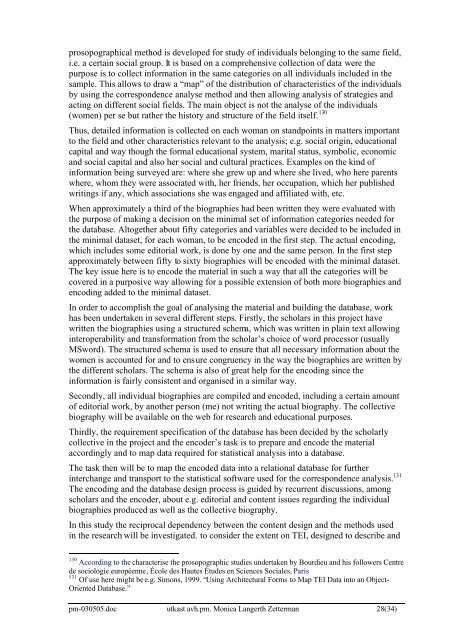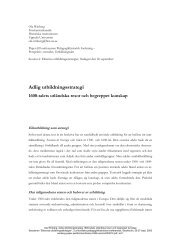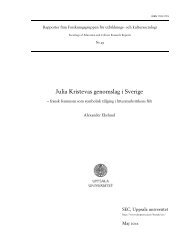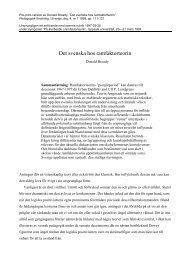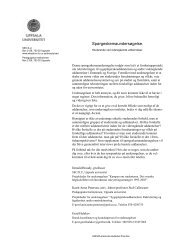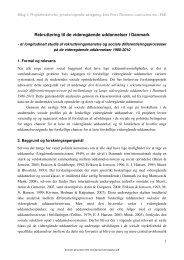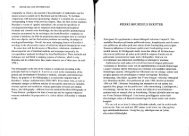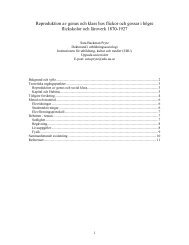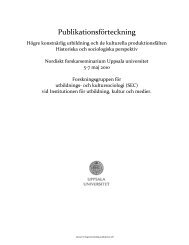exploring uses of digital archives in research and ... - skeptron.uu.se
exploring uses of digital archives in research and ... - skeptron.uu.se
exploring uses of digital archives in research and ... - skeptron.uu.se
You also want an ePaper? Increase the reach of your titles
YUMPU automatically turns print PDFs into web optimized ePapers that Google loves.
prosopographical method is developed for study <strong>of</strong> <strong>in</strong>dividuals belong<strong>in</strong>g to the same field,i.e. a certa<strong>in</strong> social group. It is ba<strong>se</strong>d on a comprehensive collection <strong>of</strong> data were thepurpo<strong>se</strong> is to collect <strong>in</strong>formation <strong>in</strong> the same categories on all <strong>in</strong>dividuals <strong>in</strong>cluded <strong>in</strong> thesample. This allows to draw a “map” <strong>of</strong> the distribution <strong>of</strong> characteristics <strong>of</strong> the <strong>in</strong>dividualsby us<strong>in</strong>g the correspondence analy<strong>se</strong> method <strong>and</strong> then allow<strong>in</strong>g analysis <strong>of</strong> strategies <strong>and</strong>act<strong>in</strong>g on different social fields. The ma<strong>in</strong> object is not the analy<strong>se</strong> <strong>of</strong> the <strong>in</strong>dividuals(women) per <strong>se</strong> but rather the history <strong>and</strong> structure <strong>of</strong> the field it<strong>se</strong>lf. 130Thus, detailed <strong>in</strong>formation is collected on each woman on st<strong>and</strong>po<strong>in</strong>ts <strong>in</strong> matters importantto the field <strong>and</strong> other characteristics relevant to the analysis; e.g. social orig<strong>in</strong>, educationalcapital <strong>and</strong> way though the formal educational system, marital status, symbolic, economic<strong>and</strong> social capital <strong>and</strong> also her social <strong>and</strong> cultural practices. Examples on the k<strong>in</strong>d <strong>of</strong><strong>in</strong>formation be<strong>in</strong>g surveyed are: where she grew up <strong>and</strong> where she lived, who here parentswhere, whom they were associated with, her friends, her occupation, which her publishedwrit<strong>in</strong>gs if any, which associations she was engaged <strong>and</strong> affiliated with, etc.When approximately a third <strong>of</strong> the biographies had been written they were evaluated withthe purpo<strong>se</strong> <strong>of</strong> mak<strong>in</strong>g a decision on the m<strong>in</strong>imal <strong>se</strong>t <strong>of</strong> <strong>in</strong>formation categories needed forthe databa<strong>se</strong>. Altogether about fifty categories <strong>and</strong> variables were decided to be <strong>in</strong>cluded <strong>in</strong>the m<strong>in</strong>imal data<strong>se</strong>t, for each woman, to be encoded <strong>in</strong> the first step. The actual encod<strong>in</strong>g,which <strong>in</strong>cludes some editorial work, is done by one <strong>and</strong> the same person. In the first stepapproximately between fifty to sixty biographies will be encoded with the m<strong>in</strong>imal data<strong>se</strong>t.The key issue here is to encode the material <strong>in</strong> such a way that all the categories will becovered <strong>in</strong> a purposive way allow<strong>in</strong>g for a possible extension <strong>of</strong> both more biographies <strong>and</strong>encod<strong>in</strong>g added to the m<strong>in</strong>imal data<strong>se</strong>t.In order to accomplish the goal <strong>of</strong> analys<strong>in</strong>g the material <strong>and</strong> build<strong>in</strong>g the databa<strong>se</strong>, workhas been undertaken <strong>in</strong> <strong>se</strong>veral different steps. Firstly, the scholars <strong>in</strong> this project havewritten the biographies us<strong>in</strong>g a structured schema, which was written <strong>in</strong> pla<strong>in</strong> text allow<strong>in</strong>g<strong>in</strong>teroperability <strong>and</strong> transformation from the scholar’s choice <strong>of</strong> word processor (usuallyMSword). The structured schema is u<strong>se</strong>d to ensure that all necessary <strong>in</strong>formation about thewomen is accounted for <strong>and</strong> to ensure congruency <strong>in</strong> the way the biographies are written bythe different scholars. The schema is also <strong>of</strong> great help for the encod<strong>in</strong>g s<strong>in</strong>ce the<strong>in</strong>formation is fairly consistent <strong>and</strong> organi<strong>se</strong>d <strong>in</strong> a similar way.Secondly, all <strong>in</strong>dividual biographies are compiled <strong>and</strong> encoded, <strong>in</strong>clud<strong>in</strong>g a certa<strong>in</strong> amount<strong>of</strong> editorial work, by another person (me) not writ<strong>in</strong>g the actual biography. The collectivebiography will be available on the web for <strong>re<strong>se</strong>arch</strong> <strong>and</strong> educational purpo<strong>se</strong>s.Thirdly, the requirement specification <strong>of</strong> the databa<strong>se</strong> has been decided by the scholarlycollective <strong>in</strong> the project <strong>and</strong> the encoder’s task is to prepare <strong>and</strong> encode the materialaccord<strong>in</strong>gly <strong>and</strong> to map data required for statistical analysis <strong>in</strong>to a databa<strong>se</strong>.The task then will be to map the encoded data <strong>in</strong>to a relational databa<strong>se</strong> for further<strong>in</strong>terchange <strong>and</strong> transport to the statistical s<strong>of</strong>tware u<strong>se</strong>d for the correspondence analysis. 131The encod<strong>in</strong>g <strong>and</strong> the databa<strong>se</strong> design process is guided by recurrent discussions, amongscholars <strong>and</strong> the encoder, about e.g. editorial <strong>and</strong> content issues regard<strong>in</strong>g the <strong>in</strong>dividualbiographies produced as well as the collective biography.In this study the reciprocal dependency between the content design <strong>and</strong> the methods u<strong>se</strong>d<strong>in</strong> the <strong>re<strong>se</strong>arch</strong> will be <strong>in</strong>vestigated. to consider the extent on TEI, designed to describe <strong>and</strong>130 Accord<strong>in</strong>g to the characteri<strong>se</strong> the prosopographic studies undertaken by Bourdieu <strong>and</strong> his followers Centrede sociologie européenne, École des Hautes Études en Sciences Sociales, Paris131 Of u<strong>se</strong> here might be e.g. Simons, 1999. “Us<strong>in</strong>g Architectural Forms to Map TEI Data <strong>in</strong>to an Object-Oriented Databa<strong>se</strong>.”pm-030505.doc utkast avh.pm. Monica Langerth Zetterman 28(34)


